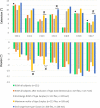The global end-ranges of neck flexion and extension do not represent the maximum rotational ranges of the cervical intervertebral joints in healthy adults - an observational study
- PMID: 34034773
- PMCID: PMC8145792
- DOI: 10.1186/s12998-021-00376-3
The global end-ranges of neck flexion and extension do not represent the maximum rotational ranges of the cervical intervertebral joints in healthy adults - an observational study
Abstract
Background: In clinical diagnosis, the maximum motion of a cervical joint is thought to be found at the joint's end-range and it is this perception that forms the basis for the interpretation of flexion/extension imaging studies. There have however, been representative cases of joints producing their maximum motion before end-range, but this phenomenon is yet to be quantified.
Purpose: To provide a quantitative assessment of the difference between maximum joint motion and joint end-range in healthy subjects. Secondarily to classify joints into type based on their motion and to assess the proportions of these joint types.
Study design: This is an observational study.
Subject sample: Thirty-three healthy subjects participated in the study.
Outcome measures: Maximum motion, end-range motion and surplus motion (the difference between maximum motion and end-range) in degrees were extracted from each cervical joint.
Methods: Thirty-three subjects performed one flexion and one extension motion excursion under video fluoroscopy. The motion excursions were divided into 10% epochs, from which maximum motion, end-range and surplus motion were extracted. Surplus motion was then assessed in quartiles and joints were classified into type according to end-range.
Results: For flexion 48.9% and for extension 47.2% of joints produced maximum motion before joint end-range (type S). For flexion 45.9% and for extension 46.8% of joints produced maximum motion at joint end-range (type C). For flexion 5.2% of joints and for extension 6.1% of joints concluded their motion anti-directionally (type A). Significant differences were found for C2/C3 (P = 0.000), C3/C4 (P = 0.001) and C4/C5 (P = 0.005) in flexion and C1/C2 (P = 0.004), C3/C4 (P = 0.013) and C6/C7 (P = 0.013) in extension when comparing the joint end- range of type C and type S. The average pro-directional (motion in the direction of neck motion) surplus motion was 2.41° ± 2.12° with a range of (0.07° -14.23°) for flexion and 2.02° ± 1.70° with a range of (0.04°-6.97°) for extension.
Conclusion: This is the first study to categorise joints by type of motion. It cannot be assumed that end-range is a demonstration of a joint's maximum motion, as type S constituted approximately half of the joints analysed in this study.
Keywords: Cervical vertebrae; Fluoroscopy; Maximum motion; Neck; Range of motion.
Conflict of interest statement
The authors declare that they have no competing interests.
Figures



References
-
- Houck J, Yack HJ, Mulhausen P. Neck mobility: the influence of age and a history of neck pain. Gait Posture. 1997;2(5):184. doi: 10.1016/S0966-6362(97)83433-9. - DOI
-
- Wu S, Kuo L, Lan HH, Tsai S, Su F. Segmental percentage contributions of cervical spine during different motion ranges of flexion and extension. Clin Spine Surg. 2010;23(4):278–284. - PubMed
Publication types
MeSH terms
LinkOut - more resources
Full Text Sources
Other Literature Sources
Medical
Miscellaneous

